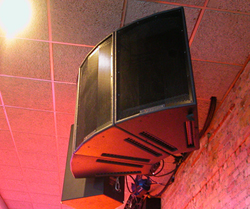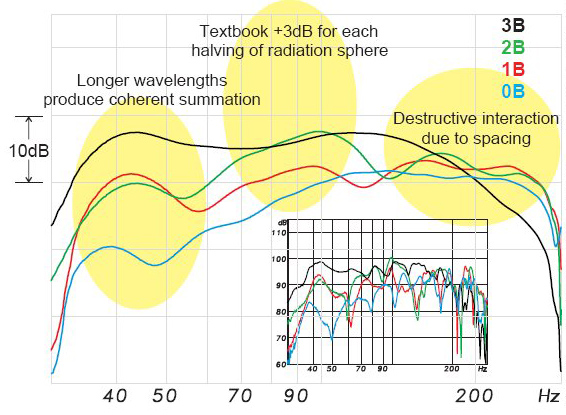
Of course there are many applications where such colorations are acceptable, but in ones where they aren’t then free space mounting, in-wall or horn loading should be considered.
Boundary loading is often touted as being desirable for subwoofers. While some impressive gains were seen at very low frequencies, it’s not likely that the boundaries available for such placements are sufficiently large and rigid to realize these benefits.
Room modes will also dominate the subwoofer response in most applications. So, the ear remains the final authority on benefits of boundary-loading subs.
An interesting sidebar to boundary loading a sub is to consider that if the sub is placed on the Genie-lift (shown above) and the mic is placed on the floor (and the mic-to-loudspeaker distance is held constant), there is no increase in level as the sub is lowered toward the floor.
Since listeners in an auditorium are near the floor, there may be no net increase in level if the subs are “ground planed” as opposed to flown.
And lastly, from a loudspeaker specification point of view, I often see loudspeaker sensitivities measured in a free-field (correct method for most) and then increased by 6 dB and specified as a “half-space sensitivity.”
The data shows that this is both erroneous and misleading. A graph of the sensitivity will show any benefits or detriments.
Microphone
The device tested was a DPA 4007 microphone. A 6-inch coaxial loudspeaker was used as the sound source. The mic was placed on the HF axis and in the far-field for each measurement.
The free-field measurement was used as a reference (0 dB line in Figure 4) and each subsequent measurement shows the difference caused by the boundary condition.

The interference above 8 kHz for “C” and “D” plots (referring to Figure 1) is caused by masking/reflections from the microphone body.
This is the result of mic capsule being placed at the boundary intersection, which puts the microphone body between the diaphragm and the sound source. This interference could be completely removed by using a very small microphone.
The “B” placement is often used for equalizing loudspeakers that are suspended above large, flat planes (i.e. gym floor).
The gain is +6 dB/boundary due to the coherent summation of the sound fields. Coherent means that the direct and reflected sound are in-phase at all frequencies of interest.
Microphones with small-diameter elements work best for use with boundary techniques.
Subwoofer
The device tested was a Bose MB4 subwoofer. Each measurement was made in the test room with no time window. This was necessary to achieve adequate resolution at the lowest frequencies.
As such, the effects of room modes can be clearly seen in the measured data (Figure 5).

1/1-octave smoothing was used to facilitate observation of the boundary gain. The interference/interaction could be avoided if the tests were made in a larger space, but the size required for true free-field evaluation of a subwoofer would be massive indeed.
Encloses spaces (rooms) have a profound effect on the response of a subwoofer, as does the proximity of the subwoofer to the boundary(ies).
An ideal 18 dB of gain for coherent summation occurs when the wavelengths are very large relative to the subwoofer size and its proximity to the boundary (40-50 Hz).
